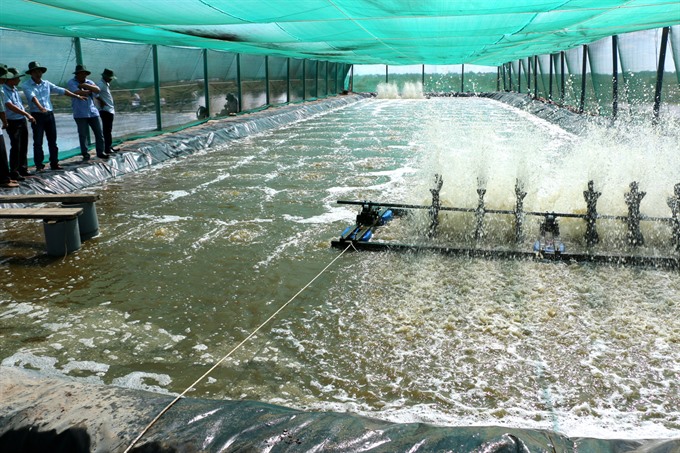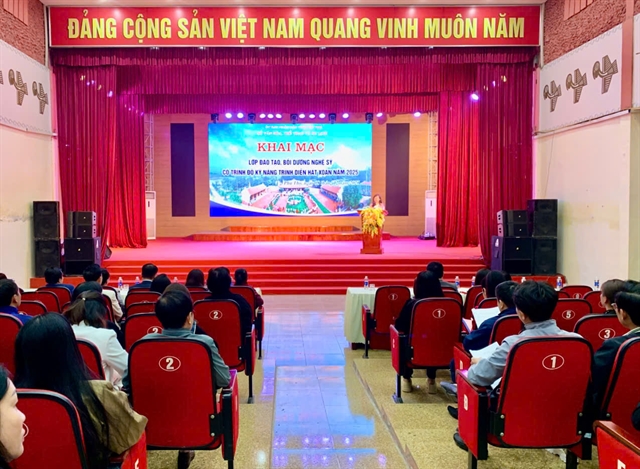 Society
Society

Hi-tech shrimp farming models – complete with net house, canvas-lined ponds to a full-fledged water treatment plant system – requires billions of đồng in investment per hectare. However, the effectiveness of such model is convincing enough that many farmers in the Southeastern region are willing to give it a try.
 |
| Following the hi-tech shrimp farming model, farmer Lê Anh Xuân keeps one-month-old shrimps in netted areas before releasing them into open-air ponds.- VNA/VNS Photo Huỳnh Sử |
HCM CITY — Hi-tech shrimp farming models complete with net houses, canvas-lined ponds and water treatment plant systems require billions of đồng in investment per hectare. However, the effectiveness of such models means many farmers in the Southeastern region are willing to give it a try.
“Previously, farmers’ mindsets were set on throwing out a sprat to catch a mackerel. Such thinking is no longer tenable,” Trần Văn Mùa – a farmer from Hiệp Phước Commune, Nhà Bè District, HCM City, who practises the new model, said.
“Now, if we want to harvest good shrimp, we need to be willing to invest,” he added.
The hi-tech model he is deploying was a result of knowledge and experience he has garnered during various trips to study successful models, both abroad and at home.
On average, the implementation of this model costs VNĐ2 billion (around $95,000). It’s pricey, but his investment has paid off, with high survival rates, annual average yield reaching as high as 120 tonnes per ha, and three shrimp crops per year - a much higher efficiency than traditional farming.
In Long Thành and Nhơn Trạch district of Đồng Nai provinces, tens of farmers are applying this model.
From two shrimp ponds with total area of 3,500 sq.m, Nguyễn Trường Đại from Nhơn Trạch district has harvested some 20 tonnes of shrimp this year.
According to Đại, with traditional techniques, he stocked 50 shrimps per m2, however, with the new technique, he can stock 200 shrimps per m2.
“With new biosecure shrimp farming technology, only the healthiest shrimps are chosen to breed, so upon harvesting, just some 20-30 can weigh 1 kilogram,” Đại told reporters from Nông thôn ngày nay (Countryside Today) newspaper.
Nguyễn Thị Lê Hoa, a farmer from Long Thành District, said that she had used the traditional way of farming white-legged shrimps but frequent disease outbreaks meant she made little money.
“Switching to the new model allows me to keep track of and proactively control the environment in the ponds, this helps to lower the risk of diseases,” she said.
Establishing a safe shrimp production area
Thanks to hi-tech farming techniques which make use of probiotics and microbial products and allow for better management of antibiotic residue, the harvested shrimp are safe for consumption.
Also under this model, farmers choose the healthiest and safest shrimps for breeding, follow regulations on water treatment and know how to utilise beneficial bacteria to fight harmful bacteria.
Also important is designing a pool that lets waste and harmful impurities settle in the pond’s bottom. Farmers must also clean the ponds every day and remove waste out of the pond.
According to statistics from Nhơn Trạch District’s Chamber of Commerce, district-wide, around ten households have made use of the new farming model and have achieved great profits.
Realising the benefits of the model, district authorities are making efforts to replicate the model district-wide.
The district will prioritise investment in essential infrastructure like roads and electricity to intensive shrimp farming zones, aiming to encourage farmers to use technology for production.
According to Mùa, there are currently eight companies willing to procure and purchase shrimp from hi-tech shrimp producers in the commune.
“These companies agree to partner with farmers, and will supply necessary materials and breeding stock. They have also pledged to buy all harvested shrimp from farmers,” Mùa said.
In Hiệp Phước Commune, Nhà Bè District, there are nine farmers currently applying the new farming techniques, with total area of nearly 15 ha.
Phạm Văn Quý, Deputy Chairman of the Nhà Bè District’s Farmers’ Association, said that these farmers are co-operating and complying with VietGAP standards to supply shrimp to the market and establish a recognisable ‘safe shrimp’ brand.
A representative from a company undertaking technology transfer to shrimp farmers in Đồng Nai Province said that, currently, they are working closely with shrimp farmers to expand the model.
The company is also the owner of a number of shrimp processing plants in Trảng Bom District, Đồng Nai Province and in Bến Tre Province so consumption of farmers’ shrimp is ensured. — VNS




